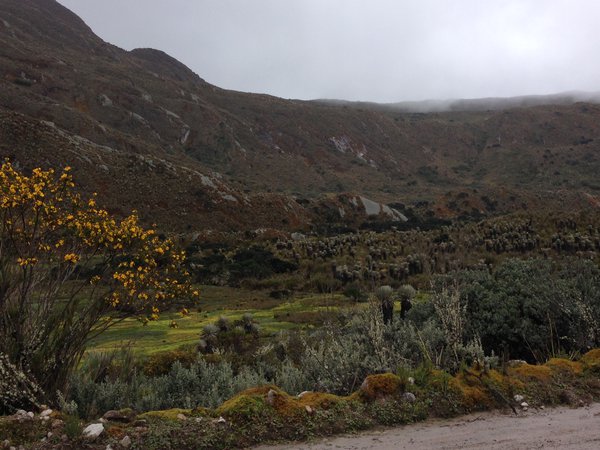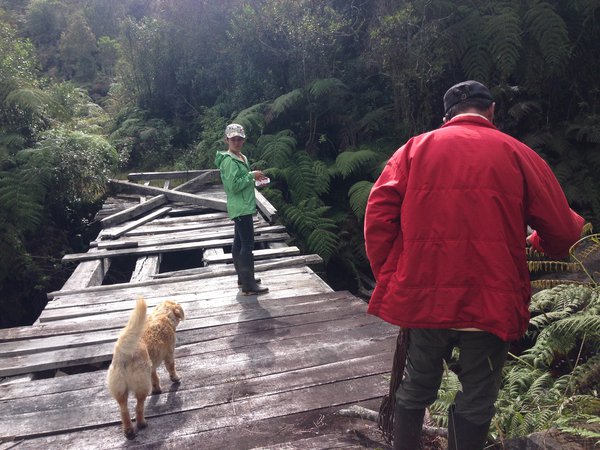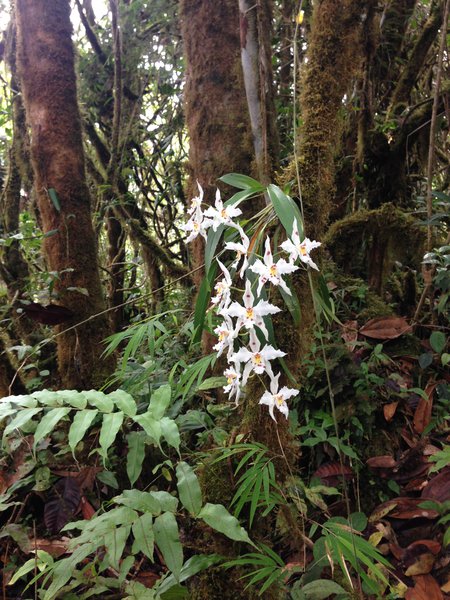
Part 1. Going with Ana
Ana and I went to that collectively-owned forest on the weekend of the 27th and 28th of May, 2017. We wanted to talk to the Promotion Committee of the Peasant Reserve Zone about a possible project on environment and peace building before going to the collective house in the forest. This could be an interesting possibility for my PhD research and I was doing preliminary fieldwork with this visit. I spoke with Sandra –from the promotion committee– two days before we left, and she said she would try to get the committee to meet on Sunday. I was unable to call her on Friday. The committee was busy on Saturday. When we arrived in the town on Saturday, we stopped by the veterinary store she ran with her husband. It was closed. We had no choice but to continue up the mountains to the forest that lay twenty kilometres away, where we would have no cell phone connectivity until the day after on our descent back to town on Monday.
The weather was gorgeous. It is always so refreshing and peaceful to be in those forests for us urban folks. Leaving chaotic Bogotá with its horrible traffic, high levels of air pollution to this beautiful mountain cloud forest, with its refreshing humidity, chilly fresh air (40-60o Fahrenheit night-day temperature), its fresh water sources, and dense vegetation. The forest keeper received us warmly as usual. He is a local tree-tomato fruit producer and takes care of the forest paths. He said there was word of paramilitary pamphlets circulating in the town, threatening five individuals, drug-addicts and the bums. It usually begins this way, this sort of “social cleansing” – a sanitized term commonly used in Colombia to describe this targeting by military trained groups. Then they target “women who talk with armed men”, then lefties and environmentalists. There was also a rumour of deaths in the neighboring town.
Fear and distrust of the peace process between FARC and the government was already coming true, only 6 months after the agreements were modified to suit right-wing demands. These voices had grown powerful after the majority in a national plebiscite in October 2016 rejected the peace agreements. The population segment who supported the peace process feared that the corrupt army and weak state would not be able –nor willing– to handle the spread of paramilitary forces in territories where FARC would disintegrate as an armed force and retreat to the Zonas Veredales. Only six months later it was clear that all over the country, paramilitary forces were spreading to ex-FARC controlled territories. These paramilitary forces were the ones began by Pablo Escobar and other drug lords to protect their lands as well as by rich cattle ranchers who feared the kidnappings from the guerrillas in the 1980s and 90s. These forces then became the hidden hand of the national army, doing the dirty work of killing and disappearing everyone who they could call a guerrilla ally. Grassroots leaders, human rights defenders, environmentalists and everyone else who did not conform to their standards became a suspect, and often a victim.
Now, two women driving “alone” along this territory became a risk. Had we put ourselves at risk? Were we being observed? Again, old fears returned. Our enthusiasm for the project vanished and we cherished even more that walk through the forest and bathing in the cold forest river. We did not know when we would return to the forest again. Any Colombian knows that pamphlets are a sign of shifts in power. If you cannot be easily identified as a local, then you are a possible target. Old fears included the possibility of armed checkpoints of any of the armed forces, house raids, and from there on, the worst possible scenarios: rapes, tortures, assassinations. It was better that I considered the possibility of not coming back for PhD fieldwork here and that I changed my research sites.
Part Two. Going with Zoe
I was back in this town after the pamphlet incident. Three months had passed and I wanted to do some interviews for my PhD research about the gendered angles of governance issues in conservation projects with campesinas and campesinos of this region (peasant women and men). Neighbours told other members of the forest collective that the pamphlets had turned out to be a strategy of some “old ladies” (viejas) to counter the growing petty drug traffic in the town and to scare off the dealers. If this was true then my fears from the last visit were unfounded, and there was nothing to fear in coming back to this research field site. It was not that the paramilitary forces were taking over this territory, but that the possibility of them arriving was used a strategy to scare off local drug dealers. Still, the whole possibility of “old ladies” using this grim strategy sounded strange too.
I invited a (female) friend to join me for this short research trip. I drove through the páramo. It was a nice but longer road trip (6 hours) than the usual four-hour route. Out through Usme you can appreciate how the urban monster of Bogotá gradually turns into a rural, agrarian landscape, seemingly unaffected by the industrial, poor, polluted southern Bogotá. Then you climb the páramo through a dirt road. I reached Chisacá lake, where Sumapaz National Park Park officials allow tourists to stop only for a quick picture. The local campesino associations opposed tourism to the páramo since the region was more peaceful after the peace agreements and their amendments after the referendum. A side effect of the peace-agreements, or a “post-conflict” scenario, if you will. With the hope of peace in these territories, urban folk had returned with their bikes, campings, and road trips. More than an economic opportunity, the local agrarian producers saw this as a threat to their lifestyle and their territory since with urban people came noise, garbage, pollution and unwelcome social dynamics.
The three environmental officers were middle-aged women in uniform, jacket and cap. They were having a hard time with the cold weather, wind, the páramo light and persistent rain. On the road were army officials of –what I imagine was– the High Mountain Battalion, a military counter-guerrilla force/body/section that emerged in the early 2000s for high mountain regions like Sumapaz. Since FARC had surrendered arms as part of the peace-agreements, the roles of the High Mountain Battalion appeared doubtful. Still, I saw young male army-labor bodies there looking bored and cold.
The National Parks official answered my questions, offered to take the typical tourist photo, and dispatched us. We signed an attendance sheet. In the days of armed conflict, two long women signing such a document in such a place, even passing on this road, was unthinkable.
●
Arriving in town, we picked up a woman in her 50s. She was walking from a vereda to the town. It was raining. As we dropped her off in town, while listening to her praises of the Pope who had just visited that week, she asked, “What are two sweet young women coming here for? You look so tiernecitas, like two cute, little sisters (hermanitas tiernecitas). Aren’t you afraid of the guerrilla? I would be afraid. They say there’s still guerrilla around. Aren’t you afraid?” My friend (a Colombian social scientist in her 30s) and I politely giggled at her hermanitas tiernecitas remark and only said we were paseando (wandering, touristing), studying the geography of the beautiful forest there. These are the specificities of doing fieldwork as a woman in rural Colombia. If we were two men of the same age, we could be suspicious of things like… working? In anything from agrarian technical support, to ecosystem conservation research, etc. But two women? “Alone”? What could they possibly be doing? As women it is safer to pasear (do tourism) and play innocent. Saying we were there to visit relatives, a local woman could trace family last names, track our social status and be even more suspicious.
●
This time in my PhD fieldwork, I wanted to interview a woman in the next vereda who had worked in an Andean-bear protection project with the regional environmental authority. I stopped at a “corner” store to ask after her. The lady at the store gave me directions to her home. I decided to stop and talk with this lady. After a while I suggested an interview, but she refused to be recorded. Of course, I should have known; why would this lady want to give a recorded interview to a stranger, about life in the countryside and conservation projects?
The white orchids in the forest were beautiful, plenty of them in bloom. It is always such a delight –mixed with the fear of unwanted visitors at night– to be here. As usual, I thought this might be the last time I would come here for fieldwork and, in general, the last time I would come here in a while. In rural Colombia you never know when you might be regarded as a threatening stranger to any of the armed forces in a particular territory.
Manuela is Colombian, she is an ecologist and a geographer with a Ph.D. from Syracuse University, and a mother. Her research focuses mainly on the Colombian Andes where she feels at home in the cloud forests and páramos.
Peasant/Campesino Reserve Zones (Zonas de Reserva Campesinas -ZRC- in Spanish) are agrarian reform and land planning designations from a Colombian agrarian law of 1994. They have been stigmatized by the national governments of 2002-2010 and 2018-2022 as being refuge zones of the FARC guerrilla. The “Final Agreement for Ending the Conflict and Building Stable and Lasting Peace” between the Colombian Government and FARC openly support the ZRC as a sustainable socio-environmental land planning mechanism.
FARC or Fuerzas Armadas Revolucionarias de Colombia, refers to a guerrilla of communist origin founded in the 1950s, now a political party Fuerza Alternativa Revolucionaria del Común.
For more context: https://en.wikipedia.org/wiki/2016_Colombian_peace_agreement_referendum.
Zonas Veredales are temporary rural camps established as part of the peace agreements so the FARC ex-combatants could establish temporarily while the next phases towards civilian life were developed.
Páramo is a tropical high-mountain peatland ecosystem beginning from 2800-4000 m above sea level.
29 June 2021

